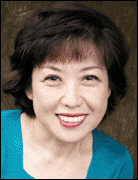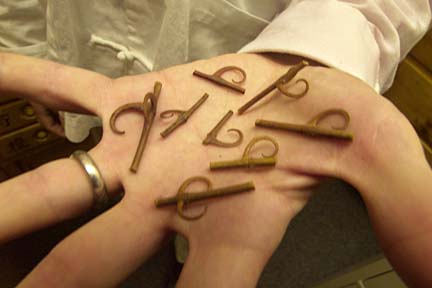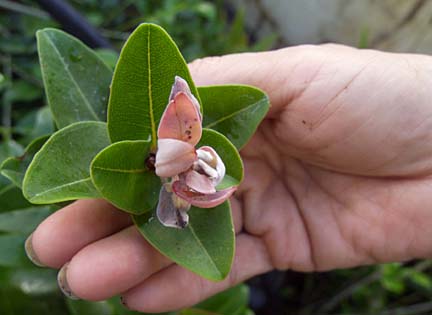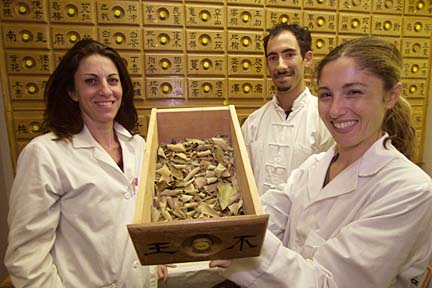


In The Garden![]()
Friday, February 8, 2002

|
Nature’s cure Admittance to Dr. Chang Yi Hsiang's medicinal garden is granted only under one condition: No one may step beyond the potted plants.
Dr. Chang's medicinal garden is
a harmonious place, thanks to
feng shui and qi gongThe dozens of plants in containers are show-and-tell samples of some of the 500 varieties of trees, bushes, grasses, vines, succulents, flowering and other plants Chang cultivates for her acupuncture and Chinese herbal medicine practice. They are a mere glimpse of the real garden spread over a few mountainside acres.
"I am sorry, my plants are fussy. They don't like strangers," Chang explains politely about her off-limits policy. "The plants, they get scared. Even if (a) sneeze (occurs), they get scared. Shoes, they don't like shoes. No, no, no. Shoes, very bad. Because shoes can carry so much from outside -- from our society's industrial atmosphere, so much chemical -- into the garden. Not good."
Her plants like "quiet and mists," which she provides amply, and "some sunlight," which happens to be plentiful in this part of Oahu. They are never subjected to man-made chemicals. Their diet, other than fastidious watering from a sprinkler system, is fortified with algae-rich water from two small water gardens nestled among the potted plants.

|
One water garden is home to five adult and three infant turtles. The water, potent with turtle waste, is reserved only for the endangered Hawaiian plants. The other water garden, filled with lotuses and a variety of small fish appropriate for good feng shui, supplies liquid fertilizer for the rest of the garden.The division is dictated by the plants. "They like different things. Turtle water is very good. Endangered plants, they like turtle water," Chang says. Other plants prefer the "lotus water," which carries the proper dose of harmony generated by a thriving blue lotus.
The mosquitos, in proliferation without pesticides in the water garden, however, aren't nearly as picky. They find one visitor as tasty and juicy as the next -- until Chang steps in to practice what she preaches.
"I have just the thing for mosquitos," she says, quickly snipping the tender shoots off a mugwort with her fingers. "Here, use this; they won't bite you anymore." Magically, the mosquitos disappear when the chrysanthemum-like scent is released from the crushed leaves.
"Mugwort is very important plant to the Chinese. It's the first herbal medicine Chinese used, back to the Stone Age," Chang says. The plant's uses were recorded in the classic medical reference book "Huang Ti Nei Ching," or the Yellow Emperor's Manual of Corporal Medicine. Called "ai yeh" in Chinese -- words uttered when one is in discomfort -- it soothes pain and "female troubles."
Mugwort doubles as a good-luck magnet to kick off the Chinese new year, Chang says. To attract "good elements," small branches are tied with red strings and hung outside the front door. For it to work properly, mugwort must be hung on the first day of the new year; the next day is too late, she says.

|
CHANG, FOUNDER of the College of Acupuncture & Herbal Medicine and a designated living Chinese treasure in Hawaii, will share her knowledge of herbal medicine and other Chinese practices at Sunday's Foster Garden Chinese New Year Festival. She and her students will display fresh and dried medicinal plant materials and explain their uses.Chang and her group also will perform Chinese palm-reading, new year's cleansing and fortunetelling rituals. Other organizations also will provide cultural displays and entertainment from 10 a.m. to 3 p.m.
Chang's medicinal plant collection isn't limited to herbs of Chinese origin. She has gathered a plethora of plants, including rare native Hawaiian species, for treatment of physiological as well as psychological ailments.
"I have something for everything in this garden. Sometimes Hawaiian plants, we have in China, too. We use for medicine, too," Chang says.
Her current garden, begun nearly 28 years ago, is also a research and experimental lab as she discovers new plants and new uses for them. Plant details are recorded in handwritten journals, in drawings and a combination of Chinese, English and scientific names in Latin.
"When I teach students, I require they know 450 medicinal plants. I know over 500 plants. I study and I keep all these books so I can teach my students," she says.
Chang started her pursuit from age 6, when she was accepted as a disciple to a Taoist "celestial master" in her native China. She lived in his care for 10 years and studied the six Chinese arts, which involve rituals for calligraphy, music, martial arts, fortunetelling, qi gong and traditional medicine.
She studied medicine at various Chinese colleges, including Beijing University, earning a doctorate in immunology. Before her master died in 1966, he appointed her heir to his practice. He also advised her to immigrate to an island, which eventually led her to Oahu in 1970; she opened her school two years later.

|
A great deal of her medicinal herbs are imported from China, while her garden provides a rich supplementary supply of materials for her patients and students. Chang also grows vegetables and other utilitarian plants, such as a soapberry tree that sprouted from a seed she collected from her grandfather's yard in China. The cherry-size berries are good for washing hair and skin, and when used to wash clothes, repels pests that like to devour natural fibers, she says.Chang rises before dawn every day to work alone in the garden. Her routines include the usual weeding, trimming and garden chores, but also her own inventive prescriptions for healthy plants.
"In the morning I always practice qi gong (an exercise of harmony and balance) with my plants. That's why I have the Chinese magnolia in the courtyard. It's good feng shui.
"When I do qi gong, I communicate with my plants in silence; I talk with them through movements. My plants like that; that's why they are happy. When they are happy, I am happy."
MEDICINAL PLANTS IN ALL FORMS MAY HELP CURE
Dr. Chang Yi Hsiang swears by natural plant remedies to alleviate human ailments. "I have never taken Western medicine in my life. I have never been sick in my life, not even a cold," she says.Generally, the entire plant may be used as medicine, with the roots as the most potent section. The flowers and leaves are less potent and are better suited for children and seniors.
Plant materials are used to brew tea, which may be sweetened with sugar cane juice, honey or brown sugar. Sometimes, the herbal teas also are essential components of tea ceremonies. Plants may be cooked in soups, sautéed or eaten raw. Or plant parts may be crushed to form concoctions for application onto the skin.
While Western science does not confirm the plant properties associated with Chinese medicine, we pass along a list of plants and their uses from Chang:
>> Native Hawaiian yellow hibiscus: The official state flower, called "big yellow flower" in Chinese, is said to be good for treatment of infections, fungus, boils, skin rashes and sinus congestion.
>> Native Hawaiian gardenia: "Zhi zi" is a handy plant, said to be good for cleaning infections and tumors, regulating menstrual cycles and promoting overall good health.
>> Lehua: Its Chinese name, "he huang hua," means "happy together flower." It refers to the sexual and youthful energy it supposedly generates.
>> Awa: While the Chinese do not specifically refer to the narcotic quality in the plant as the Pacific islanders do, the Chinese do recognize it for the euphoric youthful feeling it provides. Its Chinese name, "lao yuan," refers to rediscovery of youth.
>> Jade plant: Disregard the common type with oval leaves. Only the pointy leafed variety known as "stone lotus" is used in to treat diabetes.
>> Lady slipper orchid: Used as an antidepressant. These orchids are referred to generally as "hu de long," which means "butterfly orchids." Medicinal lady slipper orchids are called "si hu."
>> Begonia: Called "red half lotus," is used to treat ailments not visible to the eye, such as tumors and kidney stones.
FOSTER GARDEN FESTIVAL
Pizza isn't exactly a Chinese food, but it will be among the goodies offered Sunday at the Foster Garden Chinese New Year Festival.The Chinese were the originators of various Italian foods, and that's enough reason to include the cheese pies in a festival launching the Year of the Horse, says event organizer Nathan Wong.
Foster Garden Chinese New Year Festival
Place: 50 N. Vineyard Boulevard
Time: 10 a.m. to 3 p.m. Sunday
Admission: $1
Call: 522-7064
Foster Garden staff and volunteers will set up an Enchanted Wishing Tree of Lam Tsuen in keeping with Chinese New Year's traditions. Visitors may write their wishes for the new year on pieces of paper and tie them to tangerines with strings. To make the wishes come true, the tangerines must be thrown at a camphor tree and become caught in the branches. (The garden's huge camphor tree is too tall to allow any wish to come true, so the staff will choose a more manageable substitute that day.)
Chinese herbal medicine, flowering narcissus, kites, rock and mineral specimens from China, and sculptures made from recycled plants will be on display. Good-luck scrolls -- auspicious characters written on strips of red paper to be hung next to the front door -- will be made to order and available for purchase.
Gardening Calendar
Suzanne Tswei's gardening column runs Saturdays in Today.
You can write her at the Star-Bulletin,
500 Ala Moana, Suite 7-210, Honolulu, HI, 96813
or email stswei@starbulletin.com